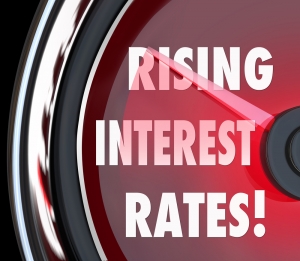It was Only a Matter of Time Before Lenders Dropped Their Cut Rates for Increases

A warning has been offered by one large mortgage lender of rising interest rates, and experts believe it is the opening of a gate in which many others will follow. Santander has given notice they are going to increase their interest rate offerings across several mortgage products on Wednesday. They are not the first to do so, but others have done so more quietly without warning. The broad announcement should put borrowers on alert, and it will come as no surprise as it was considered the lending market would pull back from its deeply competitive mode and take footing in a less risky lending market.
Last year, it was believed the Bank of England’s Monetary Policy Committee (MPC) had reached the peak standard base interest rate level and inflation was on its way to target level of 2.0%. It would soon follow, after reaching the target rate, that consumers would begin to feel the grip of higher pricing ease.
In the beginning of 2023, inflation reached double digits, by May it had dropped to a level of 6.9%, then in August, and repeating in September, it had declined to 5.9%. It was then the MPC abandoned rate hikes. There had been fourteen consecutive base rate increases starting in December 2021 when the rate was at an all-time historic low of 0.1%. The base rate had risen to 5.25% by September 2023 and the majority vote of the MPC to hold the rate steady was a sign of optimism.
By November, inflation had dropped to 3.9%. Again, the MPC held the rate steady, and did so again in December despite a slight increase to inflation of 4.0%. There was not a scheduled MPC meeting for January, so the rate remained at 5.25%, and inflation remained steady at 4.0%.
In January, forecasts called for inflation to fall slightly below target rate by the second quarter of the year. The housing market was slowing, but remaining resilient and consumers still struggling under winter’s energy costs and inflation would find relief soon as spring took hold and inflation continued its downward trajectory. Optimism in the coming economy grew.
However, the lending market had lost the attention of borrowers. The housing market was being lifted by many cash only buyers, and data revealed first time home buyers were stepping away from the market despite higher rental costs. Homeowners were also finding the current offers of lending rates uncomfortable as they came to the end of their fixed rate terms, which had been obtained when borrowing was at the lowest it had been back in 2021 and the start of 2022. For in January 2022 the base rate was only 0.25% and increased to 0.50% in February 2022.
The lending market in need of drawing the eye of borrowers and the optimism in the economy allowed lenders to push aside the risk of lending perception. While the MPC did not meet in January, and the base rate remained steady, lenders began their own rate cuts. New mortgage and remortgage products began to appear rapidly in the lending market at new lower rates with some below the base rate and falling below 5.0%.
The remortgage lending market was more restrained than the mortgage lending market. There were lower rate deals offered for buyers than homeowners, but still the offers were competitive and unexpectedly low, and the lending market brought in new customers.
While homeowners were not finding the same number of opportunities in remortgage products, and the absolute best deals were reserved for those with loan to value (LTV) that would reflect high levels of built equity and less risk for lenders, there were attractive offers. Until those began to quietly disappear.
Slowly, the number of surprisingly low interest rate remortgages coming to the market slowed, then stopped, and began to be pulled. It was only a matter of time before the same occurred in the home buyer realm of borrowing.
Inflation is stubborn currently. It has not followed the quick and steady decline it exhibited in November. Wage increases have allowed spending to continue rather than higher interest rates holding spending down to bring inflation under control. This has been pointed out by experts that warn borrowers should not expect a return to the interest rates seen during the pandemic, and to not expect a cut to the base rate to signal more to come after. Inflation may be with us longer than expected and that means borrowing will remain a difficult financial strain on consumers, including homeowners facing higher repayments as their fixed mortgage terms come to an end.



